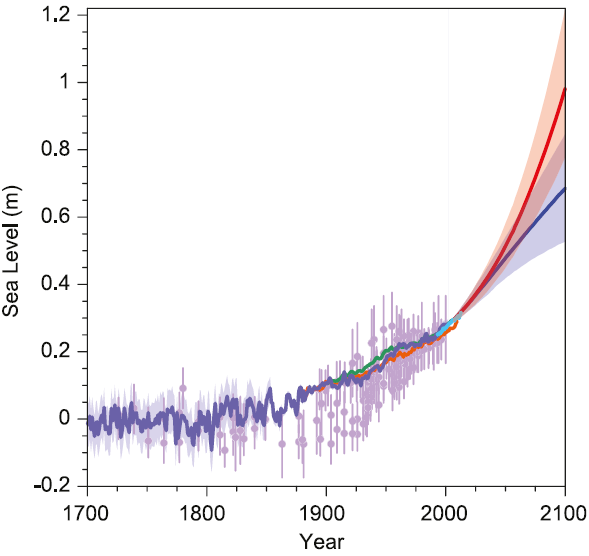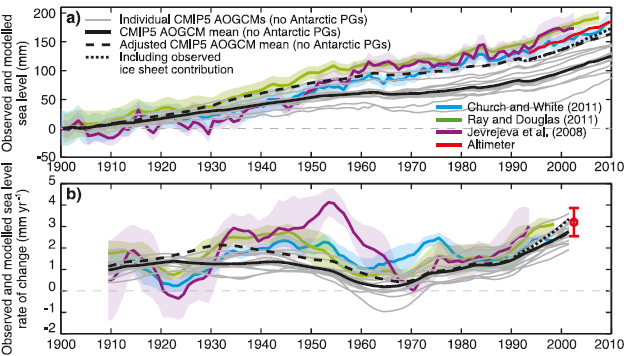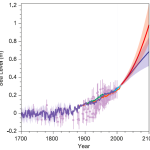A: Nothing good. See the plot below of observed past and predicted future sea level (rise). Note the two plotted future scenarios are based on the new Representative Concentration Pathways (RCPs): plausible trends in atmospheric CO2 (and other greenhouse gases) concentration named for the corresponding additional heat retained by 2100 in W m-2.  For the past, proxy data are shown in light purple and tide gauge data in blue. For the future, the IPCC projections for very high emissions (red, RCP8.5 scenario) and very low emissions (blue, RCP2.6 scenario) are shown. Source: IPCC AR5 Fig. 13.27. From RealClimate:
For the past, proxy data are shown in light purple and tide gauge data in blue. For the future, the IPCC projections for very high emissions (red, RCP8.5 scenario) and very low emissions (blue, RCP2.6 scenario) are shown. Source: IPCC AR5 Fig. 13.27. From RealClimate:
Let us jump straight in with the following graph which nicely sums up the key findings about past and future sea-level rise: (1) global sea level is rising, (2) this rise has accelerated since pre-industrial times and (3) it will accelerate further in this century. The projections for the future are much higher and more credible than those in the 4th report but possibly still a bit conservative, as we will discuss in more detail below. For high emissions IPCC now predicts a global rise by 52-98 cm by the year 2100, which would threaten the survival of coastal cities and entire island nations. But even with aggressive emissions reductions, a rise by 28-61 cm is predicted. Even under this highly optimistic scenario we might see over half a meter of sea-level rise, with serious impacts on many coastal areas, including coastal erosion and a greatly increased risk of flooding.
As this graph makes clear (look at the lower panel) the observed rate of sea level rise is increasing.  Fig. 3. Modelled versus observed global sea-level rise. (a) Sea level relative to 1900 AD and (b) its rate of rise. Source: IPCC AR5 Fig. 13.7.
Fig. 3. Modelled versus observed global sea-level rise. (a) Sea level relative to 1900 AD and (b) its rate of rise. Source: IPCC AR5 Fig. 13.7.
“For an unmitigated future rise in emissions (RCP8.5), IPCC now expects between a half metre and a metre of sea-level rise by the end of this century. The best estimate here is 74 cm. By 2300, for unmitigated emissions IPCC projects between 1 and more than 3 meters of rise.”
On the low end, the range for the RCP2.6 scenario is 28-61 cm rise by 2100, with a best estimate of 44 cm. Now that is very remarkable, given that this is a scenario with drastic emissions reductions starting in a few years from now, with the world reaching zero emissions by 2070 and after that succeeding in active carbon dioxide removal from the atmosphere. Even so, the expected sea-level rise will be almost three times as large as that experienced over the 20th Century (17 cm). This reflects the large inertia in the sea-level response – it is very difficult to make sea-level rise slow down again once it has been initiated. This inertia is also the reason for the relatively small difference in sea-level rise by 2100 between the highest and lowest emissions scenario (the ranges even overlap) – the major difference will only be seen in the 22nd century.
Although estimates for sea level rise through 2100 in the new report (AR5) are about about 60% greater than in the previous edition (AR4), they are still considered quite conservative and probably exaggerate uncertainty at the lower range. Read the whole piece here

Leave a Reply